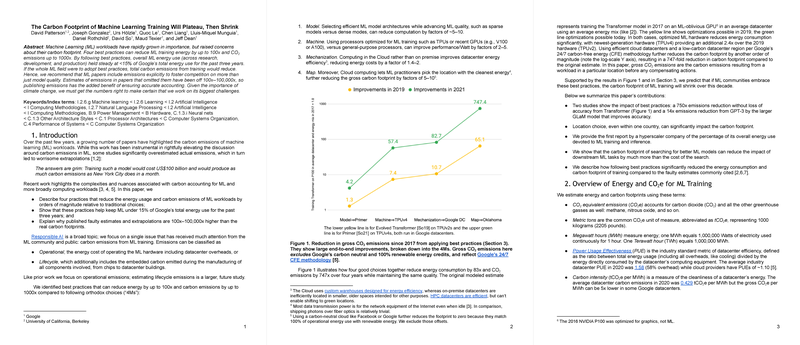The Carbon Footprint of Machine Learning Training: Current Trends and Future Prospects
The paper "The Carbon Footprint of Machine Learning Training Will Plateau, Then Shrink" explores the environmental impacts of ML workloads, particularly focusing on the carbon emissions from ML training processes. The authors propose a structured set of best practices to mitigate these impacts, emphasizing the importance of accurate emissions estimation and reporting.
Key Insights
The authors identify four best practices, collectively termed the 4Ms, which can drastically reduce energy consumption and carbon emissions in ML:
- Model Selection: Implementing efficient ML architectures, such as sparse models, can reduce computational demands significantly.
- Machine Utilization: Employing specialized hardware like TPUs or advanced GPUs enhances performance-per-watt efficiency.
- Mechanization: Utilizing cloud-based environments rather than on-premise setups escalates datacenter energy efficiency.
- Mapping: Selecting datacenter locations with lower carbon energy sources substantially diminishes carbon footprints.
The application of these best practices has proven effective, with the paper documenting an 83x reduction in energy usage and a 747x decrease in CO₂ emissions over the past four years.
Empirical Evidence
Empirical validation is provided through case studies on popular models like Transformer, GPT-3, and GLaM. The studies showcase substantial reductions in emissions without compromising model accuracy. For instance, leveraging the newest hardware and optimal datacenter locations has led to a 14x reduction in CO₂ emissions for GLaM compared to its predecessor GPT-3.
Broader Implications
The paper argues that if the ML community adopts these strategies broadly, the carbon footprint of training could not only stabilize but decrease over time. The authors encourage the inclusion of emissions data in ML publications to foster accountability and drive competition towards lower emissions.
Furthermore, the authors critique previous studies that overestimated emissions due to lack of adequate data or misunderstanding of ML processes, stressing the importance of transparent emissions reporting.
Future Developments
The trajectory of ML efficiency suggests continuous improvement through technological advancements and methodological refinements. The research underscores potential transitions to more energy-efficient algorithms and greener computing infrastructures.
The paper also highlights the lifecycle costs of manufacturing computing components as a larger concern compared to operational emissions, suggesting a possible shift in focus for future research.
Conclusion
This comprehensive examination offers valuable direction for reducing ML's environmental impact. By adopting the outlined best practices, the field may see a notable decrease in carbon emissions. As technology and algorithms continue to evolve, ensuring accurate reporting and efficient practices becomes crucial in addressing both present and future climate challenges related to ML training.
